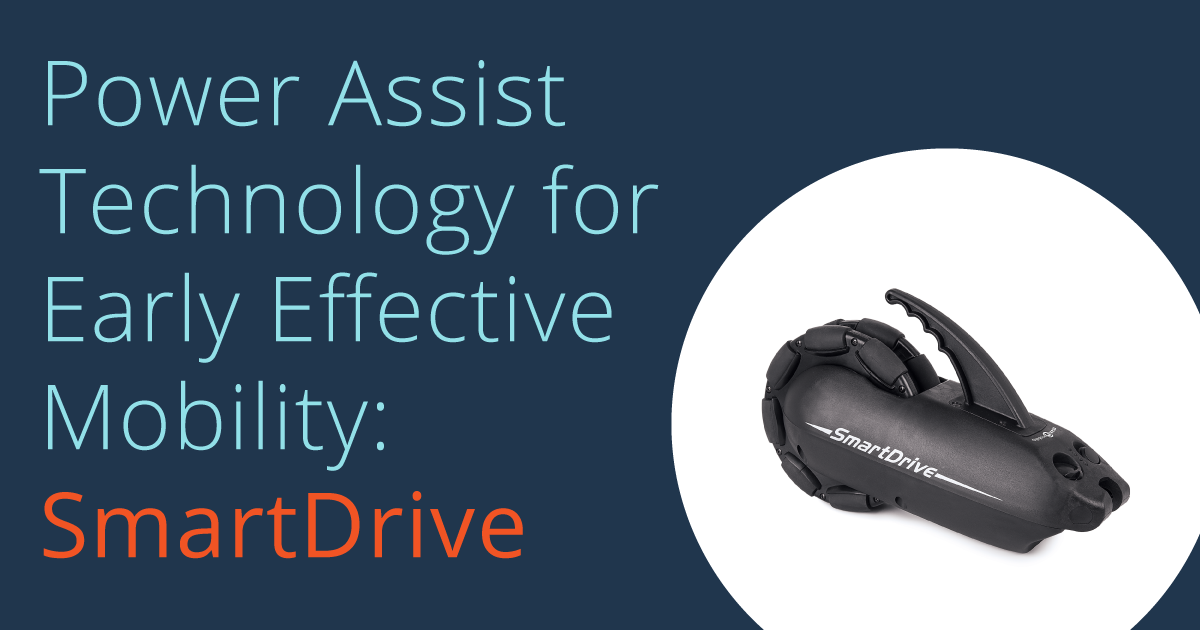Part 6 in our series looking at pediatric independent manual mobility. See Part 1, Part 2, Part 3, Part 4, and Part 5.
This week we are focusing on power assist and how it can enable efficient independent mobility. The format will look a little different as I am sharing my conversation with Devon Doebele, our resident power assist expert at Permobil. Devon is a PTA and has spent the past five years educating therapists and end users on the benefits of power assist, specifically SmartDrive. He has done a fantastic job of keeping up with end users who use SmartDrive and has had the privilege of seeing the long-term benefits. Today we are focused on the pediatric population, and I asked Devon several questions that I had regarding children using a SmartDrive. Check it out.
Stacey Mullis: What is SmartDrive?
Devon Doebele: SmartDrive is a power assist technology that attaches to the rear of a manual wheelchair. It helps with the push phase of manual wheelchair propulsion, making it easier for manual wheelchair users to propel their wheelchair.
Stacey: At what age would you consider power assist with kids? Is the size of SmartDrive always the same regardless of the size of the chair?
Devon: I’ve seen some pretty young kids do very well with SmartDrive. It works great because it can go on their small chairs and be programmed for safety. So long as the kids have the physical and cognitive capabilities, it is a great option. But as far as age? I’d say if they are independent with a manual wheelchair but need a little extra help, it’s worth a shot.
Stacey: Yeah, I can see that. If lack of endurance keeps them from being independently active, I could see it being a great solution. I’m just thinking of those tiny chairs for two- to three-year-olds. Does a SmartDrive fit on those?
Devon: And yes, endurance as well as strength for ramps/hills. No more having to get pushed by mom or dad!
The SmartDrive can attach to the TiLite Pilot ultralight wheelchair with the following measurements: 9” wide or greater, 22” or 24” wheels, rear seat-to-floor height greater than 13.5”.
Stacey: What lifestyle advantages are there to using power assist?
Devon: One great advantage is transport. If a child can transfer, she probably prefers to sit in the car with her family or friends rather than in her wheelchair with tie downs.
Another great advantage is efficiency at school, being able to do what we take for granted: getting to class on time. And not all sweaty from pushing! And getting through heavy school doors, or holding the door for the ladies and still being able to keep up with my buddies.
![]()
The coolest part is they don’t HAVE to use it in the classroom where not needed.
Then there is hopping in your friend’s car to go the mall or park or movies. Can’t do that in a power chair. And once there, you don’t need friends to push you around. So now they have much more independence and opportunity for participation with peers.
Then, work age comes around. Depending on the job and environment, there may be vocational aspirations that can’t be met or challenging to achieve without the help of SmartDrive
Then there is dating...who wants to have to be pushed up the ramp at the pier? Not me.
And to be able to hold your partner’s hand on a walk? Can’t be done without a SmartDrive. Little things like that have a major impact on self-esteem and quality of life. Things we take for granted.
Stacey: What physical advantages are there to using power assist?
Devon: The shoulders, elbows and wrists were not designed to be pushing manual wheelchairs. And over time the manual chair user may start to develop overuse syndrome. What does this mean? Increased pain and fatigue from pushing. This leads to slowing down, doing less, and participating less. It creates a downward spiral that can lead to big life changes: like needing to transition to a power wheelchair, the last thing that someone who is independent in a manual chair wants to do. Having a SmartDrive early in a wheelchair users life in a manual chair can help to prevent this and facilitate a high level of independence and quality of life long into the future.
Stacey: This is great information. Thanks for visiting with me today.
Devon: It was my pleasure.
As you can see it was a great conversation and my enquiring mind got some answers! If you have further questions about how SmartDrive could work for your child, please reach out to the Permobil Clinical Team.
Check out next week’s blog where I will begin the discussion of power mobility options for children. You don’t want to miss this as there are innovative methods of power mobility on the market that can bring out the best in your child and allow for early childhood mobility experiences!

Stacey Mullis, OTR/ATP
Director of Clinical Marketing
Stacey is Director of Clinical Marketing. She graduated from Western University in London, Ontario, Canada with a BA Linguistics and BSc Occupational Therapy and has practiced as an OTR for over 20 years. With experience in pediatrics, inpatient/outpatient rehabilitation, long term care, and home health, Stacey has faced the challenges first hand of providing appropriate seating in various clinical settings. This led her to pursue an apprenticeship at Care Partners Seating Clinic in Asheville, NC to advance her skills, and she obtained her ATP certification in 2012. Mullis is a member of the NCOTA, CTF, NRRTs, RESNA, and AOTA.

